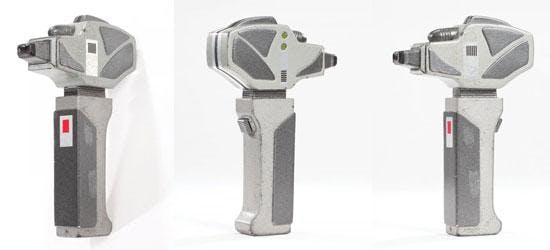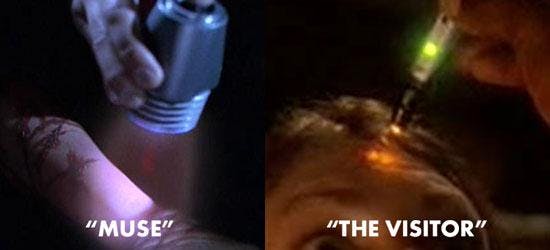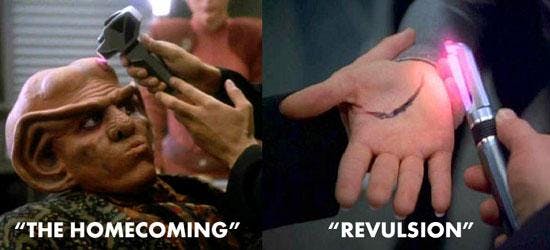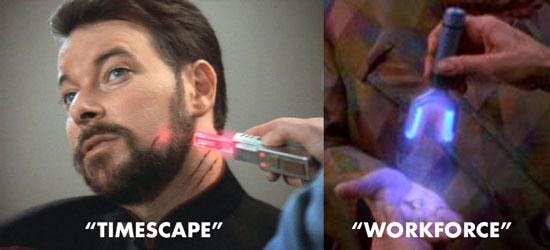
There is no place anywhere on a Federation starship where Band-Aids are kept. Antibacterial ointment isn't even a thing they've heard of unless it's in a history book. Present Dr. Leonard McCoy with a needle and thread for stitches and you might get a glare somewhere on the line between incredulous and pitying (unless he's high on cordrazine, in which case you're likely to get a wild-eyed rant). If you're a Starfleet officer with a scrape, scratch, or cut, you can report to sickbay and get it all healed up before the blood's even dry, thanks to a particular handheld marvel of future technology.

Meet the dermal regenerator, which lives up to its name by firing a beam of energy designed not to destroy, but to repair: the special radiation it emits stimulates the dermis (layer of skin) to regenerate, growing literally before your eyes to heal superficial wounds. Who needs a Band-Aid or stitches when you can just regrow damaged skin? You wouldn't even need to slap antibacterial ointment on it afterwards; the skin is, after all, your body's first protection against the nastiness of the outside world anyway.
We've all known the pain and annoyance of getting a scrape and digging through the medicine cabinet looking for a Band-Aid or some ointment, only to come up empty. Fortunately for many of us, we can replace them by stopping at a drugstore the next time we leave the house. But what if you're in space? You're stuck with whatever got packed in the first aid kit, and it's not like they can just send some more up to you in the mail. NASA, being highly sensible about the need for a new way to provide wound care in environments where medical supplies might be in limited supply and hard to restock, seems to agree. This is probably why they signed some patent license agreements with a company called GRoK Technologies back in February to get started developing the technologies that could one day give us a dermal regenerator.


One of GRoK's ventures is something they call BioReplicates, which are 3D models of human parts — made out of human tissue. This is an incredibly important first step. Right now, the permissions surrounding human testing for new medical technologies are labyrinthine and laborious, though probably with good reason. If you can't test something on people, you can probably turn to animals, but there are two problems with that:1. The first problem is that animals are different from humans. Their systems and organs aren't exactly the same as ours, so sometimes they react differently. Testing a particular chemical, technique, or technology on an animal could give us a general idea of how a living system might react, but it's not an exact 1:1 mapping.2. The second problem is animal testing itself. True, sometimes it's the only way to get halfway decent scientific data when you're trying to test something, but on some level it just feels awful and barbaric.BioReplicates would change all this. Want to see how human skin would react to your new experimental healing ray? Try it out on a sheet of BioReplicate skin instead of shooting it at a nervous volunteer or a caged bunny! (Or on an uninhabited planet in the Omicron Delta region.)

One of GRoK's other technologies is called Scionic. Details on this one are scant, but the press release says it "could lead to the development of medical devices designed to target musculoskeletal pain and inflammation in humans and animals noninvasively and without the use of pharmaceuticals." If we had to guess — and this is just a guess — Scionic sounds like it might use focused sound waves to promote regeneration in bone and muscle tissue. If this sounds crazy to you, remember that one of the most-widely accepted theories on why cats purr is that the vibration aids in the healing process. But again, just a guess.So Scionic might be using sound to heal. Can we use anything else to heal? How about lasers? Of course we can use lasers. Harvard's Wyss Institute has discovered that if you point a laser at a damaged rat tooth, it grows back more than it otherwise would without laser-zapping it. Laser light, it would seem, somehow sets off a chain reaction that stimulates dental stem cells to grow into new tooth material. They think it might have applications in other tissues than teeth — skin, anyone? But at last report, the researchers were busy setting up human trials to see if it works on our own teeth as opposed to those of rats.


The only downside we can see is that the laser wavelength they used is in the infrared range (around 700 nanometers), making it invisible to the naked eye. What if future testing reveals that the ideal laser wavelength required to promote skin healing turns out to be in the 400nm range — in other words...pinkish purple? Wouldn't that be an amazing coincidence!--Jon Sung is a contributing writer for XPRIZE and copywriting gun-for-hire to startups and ventures all over the San Francisco Bay area. When not wrangling words for business or pleasure, he serves as the captain of the USS Loma Prieta, the hardest-partying Star Trek fan club in San Francisco.XPRIZE is an innovation engine. We design and operate prize competitions to address global crises and market failures, and incentivize teams around the world to solve them. Currently, we are operating numerous prizes, including the $30M Google Lunar XPRIZE, challenging privately funded teams to successfully land a robot on the Moon’s surface, and the $10M Qualcomm Tricorder XPRIZE, challenging teams around the world to create a portable, wireless, Star Trek-inspired medical device that allows you to monitor your health and medical conditions anywhere, anytime. The result? Radical innovation that will help us all live long and prosper. Sign up today to join our mission, be a part of our campaign and win collectibles at: tricorderfederation.org.





